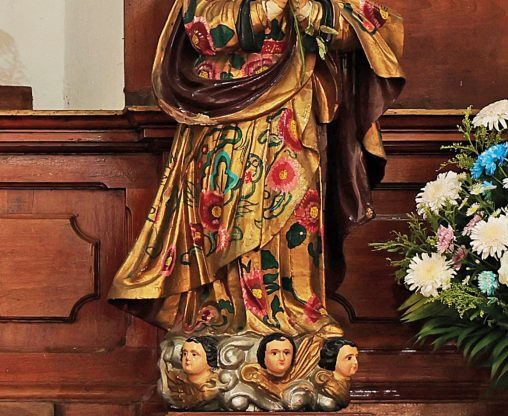Author: Carlos F. Cámara Gutiérrez
Discover the multiplatform project “100 jewels of sacred art from the Yucatan Peninsula” and let yourself be captivated by the legacy and history of sacred sculptures
Las religious sculptures in Yucatanarising during the colonial eraare not mere works of art, but authentic living testimonies that connect with history and culture.
Creations of talented local artisans and artists, these sculptures played a fundamental role in the evangelization process, acting as educational tools that transmitted religious teachings to the Mayan community, indicates the anthropologist Indalecio Cardeña Vázquez.

“Beyond their indisputable beauty, the veneration of the sacred images that adorn our churches is deeply rooted in the faith and cultural identity of those who venerate them.”, he emphasizes.
Through representations of crucial moments from the Bible and the lives of the saints, the historian adds, these effigies created an environment conducive to spiritual reflection, giving the temples a sacred and reverential character.
Without a doubt, living history through these artistic expressions is an experience that invites us to rediscover our roots.


Yucatecan devotion, reflected in religious sculptures
Each sculpture, loaded with symbolism and history, becomes a reflection of the collective devotion that unites the community.
They are guardians of ancestral traditions and bearers of stories that transcend time, says the professor of the Conciliar Seminary of Yucatán when analyzing the 28 pieces in the Images section of category b) Wood and stone sculptures of the project “100 jewels of sacred art from the Yucatan Peninsula”.


“Each carving, from a saint to the Virgin Mary, evokes feelings of love, respect and hope, serving as spiritual anchors that strengthen the emotional ties between parishioners and their beliefs,” he emphasizes.
“These jewels of sacred art are compendiums of a living spirituality that continues to resonate in hearts”.
“If we delve into the soul of the peninsula, we find religious sculptures that have left an indelible mark on the culture and devotion of the people.“, said.


“Figures like the Virgin of Izamal, patron saint of Yucatánwhich stands as a symbol of hope and protection, or the Christ of the Blisters, which radiates a deep sense of faith, bringing together those who seek comfort and spiritual guidance, are examples of that fervor.”, explains the researcher.
Jewel No. 52: Virgin of the Immaculate Conception, Patroness of Yucatán, in the church of Izamal
Location:
The image is found in the central niche of the main altarpiece in the conventual temple of San Antonio de Padua, in this Magical Town located 67 kilometers from Merida.
toponym:
Izamal derives from the name of the founder of this site, It changespre-Hispanic Mayan priest of the Itzamna deity o Itzamat.
Construction period:
This size of Virgin Maryin his advocacy of the Immaculate Conceptionit is said to be one of the two sculptures that Friar Diego de Landa ordered to bring Guatemalaaround 1560.
Most relevant feature:
The neat and beautiful carving of the Marian image, to which an ancient origin is attributed, and the great devotion that it awakens in Yucatán are its most appreciated attributes.
patronal festival:
The celebrations of this dedication to the Virgin Mary begin in the first days of December and culminate on the 8th, with great religious and popular events.
It also highlights the Holy Kingsin the Tizimín churchwhich consolidate its status as the second most important sanctuary in the world dedicated to these Magi of the East.
“Each figure, carved with humility and reverence, tells a story, revealing the rich culture that defines us”.


Pulpits, another jewel of sacred art in Yucatán
The president of the Circle of Humanistic Studies of Yucatán explains that sacred furniture, such as pulpits and baptismal fonts, are fundamental pillars in colonial churches. These elements, beyond their practical function, create an atmosphere of respect and reverence, facilitating the spiritual connection of the faithful with the divine.
“Pulpits are not just preaching platforms; They are spaces where the teachings that nourish the soul are shared“.
“Baptismal fonts symbolize spiritual rebirth, beginning the path of faith. Together, these sacred furniture weave a web of faith and beauty, transforming the sacred space into a spiritual refuge,” he defines.


The specialist considers that, despite the challenges they have faced, including the period of destruction during the Revolution and abandonment due to their low valuation, the figures of sacred art in Yucatan maintain their cultural relevance.
“Their importance not only persists, but grows stronger, fueled by the stories of devotion that surround them.“.
“Each restoration or replacement, far from diluting its essence, rekindles the emotional connection with the community, reminding us of the vitality of our traditions. Sacred art in Yucatán stands as a living legacy that invites us to honor our roots,” he explains.
“Did you know that the multiplatform project “100 jewels of sacred art from the Yucatan Peninsula” Is it a journey through a unique experience? Let yourself be surprised by each masterpiece that guides your steps along a spiritual path brimming with culture, art and history”, points out anthropologist Cardeña Vázquez.
How to acquire “100 jewels of sacred art from the Yucatan Peninsula?”
The products of “100 jewels of the sacred art of the Yucatan Peninsula” can be purchased at:
YUCATAN DAILY CLUB
COPPEL ONLINE
FREE MARKET
*Coming soon to: Amazon, Dante Bookstores and Mérida Airport
Prices
Limited Edition in Spanish – Hardcover – Now available
- Regular price $1,600.00
- Yucatán Daily Subscriber Price $1,449.00
Standard Edition in Spanish – Softcover – Now available
- Regular price $749.00
- Yucatán Daily Subscriber Price $649.00



